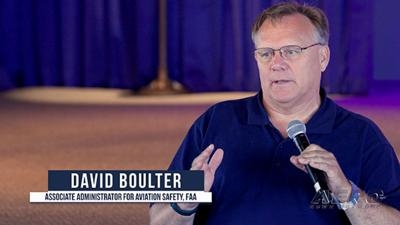Deviation from the Trottenberg, Thomson, and Washington Means
FAA Acting Associate Administrator for Aviation Safety David Boulter heads up a veritable brigade of over 7,500 aerospace and administrative professionals tasked with setting, overseeing, and enforcing aviation industry safety standards.

The whole of U.S. scheduled and unscheduled airlines, aircraft and component manufacturers, maintenance facilities, Advanced Air Mobility (AAM), Unmanned Aerial Vehicles (UAV) concerns, and every manner of aviation professional fall within the regulatory purview of Boulter and his minions.
David Boulter’s aviation credentials are well-earned and legitimate—the sort of credentials conspicuously absent from many FAA managers. In addition to holding Airline Transport Pilot, CFI, CFII, and MEI tickets, Boulter is a former Part 121 and 135 PIC, check-airman, and chief-pilot. All told, Boulter holds type-ratings in CL60 (Bombardier Challenger 600 series), BE30 (Beechcraft Super King Air 300), EMB-110 (Embraer Bandeirante), and CV24-34-44 (Convair CV-240, 340, 440) aircraft.
During a recent interview officiated by the NBAA, Boulter set forth his position vis-à-vis a number of challenges with which the FAA and the aviation industry are currently and contemporaneously faced:
Q: How does the FAA engage with Congress on the reauthorization effort and what are your priorities for the bill?
A: “In addition to the FAA’s contribution to the reauthorization proposal submitted by the Office of Management and Budget, the FAA regularly provides technical assistance to legislative proposals at the request of members of Congress. The FAA also provides updates to Congress through hearings and briefings.
“While the FAA defers to the White House on the final proposal for the 2023 FAA Reauthorization, the agency continues to share Congress’s interest in maintaining the safest aviation system in the world.”
Q: In light of the recent runway incursions and near mid-airs collisions, what action is the FAA taking to investigate and prevent future incidents?
A: “The FAA convened a Safety Summit in March to review and assess the safety measures and systems currently in place. An uptick in serious incidents demonstrates the need for continued vigilance and attention to mitigation of safety risks. The FAA stressed the need for operators to consistently analyze Safety Management Systems (SMS) data to enable better detection of emerging safety issues.
“Following the summit, we published a Safety Alert for Operators, SAFO 23002, Aviation Safety Call to Action, which provides a list of items operators should consider. We encourage all operators to review the SAFO and review best practices for safe operations.
“Our existing collaborations with industry through the Commercial Aviation Safety Team (CAST) and the General Aviation Joint Safety Team (GAJSC) continue to monitor and act on safety data received from the Aviation Safety Information Analysis and Sharing system (ASIAS), which gathers data from the FAA, manufacturers, industry groups, and operators. It pulls data trends that will allow identification of risks and mitigations.”

Q: How is the FAA improving training?
A: “An industry-led initiative guided by the FAA has developed standardized curricula as a new and voluntary way for Part 142 training centers to provide Part 135 training.
“The Gulfstream G-V standardized curriculum and the Instructor/Check Pilot Qualification curriculum was published in February. More curricula should be published later this year.
“The FAA appreciates NBAA and its members on the Training Standardization Working Group who are on the leading edge of this effort. The FAA’s interest is producing a quality curriculum focused primarily on improving flight safety and training consistency along with administrative efficiency.
“Thanks to recommendations from the Safety Oversight and Certification Advisory Committee (SOCAC), and the Flight Standards Transparency, Performance, Accountability, Efficiency ARC, we are looking at opportunities for the FAA and industry to conduct joint training.
“We’re conducting a skills gaps assessment in Aircraft Certification to assess the agency’s technical workforce. A process is now in place for a competency review every three years.”
Q: With the introduction of Advanced Air Mobility (AAM) and electric Vertical Take-Off and Landing (eVTOL) vehicles, how is the FAA taking proactive steps to ensure the new technology will be operated and integrated safely?
A: “The FAA continues to make progress in the type certification of powered-lift aircraft and necessary modifications to operational regulations to ensure safe integration of these aircraft into our dynamic air traffic system. In addition to proposed airworthiness criteria for Joby [Aviation] and Archer [Aviation], the FAA has also recently published proposed updates to the air carrier definitions in Parts 110 and 119 to include powered-lift.

“Several rulemaking efforts have begun in support of operational certification. The FAA will utilize waivers and exemptions where required. Near-term operations will be piloted, type certificated electric VTOL (eVTOL) aircraft operating in currently defined routes and procedures.
“To enable initial AAM operations, the FAA is developing a Special Federal Aviation Regulation (SFAR) Notice of Proposed Rulemaking (NPRM) to create a regulatory framework to permit operation of powered-lift aircraft. The SFAR NPRM will propose alternate eligibility requirements to safely certificate initial groups of powered-lift pilots, as well as determine which operating rules to apply to powered-lift aircraft. Powered-lift will be type certificated as special class aircraft under the existing regulations. The public will have the opportunity to comment after the NPRM is published, expected by June 2023, with the final rule expected by December 2024.”
 ANN's Daily Aero-Term (04.30.24): Runway Centerline Lighting
ANN's Daily Aero-Term (04.30.24): Runway Centerline Lighting ANN's Daily Aero-Linx (04.30.24)
ANN's Daily Aero-Linx (04.30.24) Airborne 04.24.24: INTEGRAL E, Elixir USA, M700 RVSM
Airborne 04.24.24: INTEGRAL E, Elixir USA, M700 RVSM Airborne 04.29.24: EAA B-25 Rides, Textron 2024, G700 Deliveries
Airborne 04.29.24: EAA B-25 Rides, Textron 2024, G700 Deliveries Airborne-NextGen 04.23.24: UAVOS UVH 170, magni650 Engine, World eVTOL Directory
Airborne-NextGen 04.23.24: UAVOS UVH 170, magni650 Engine, World eVTOL Directory





